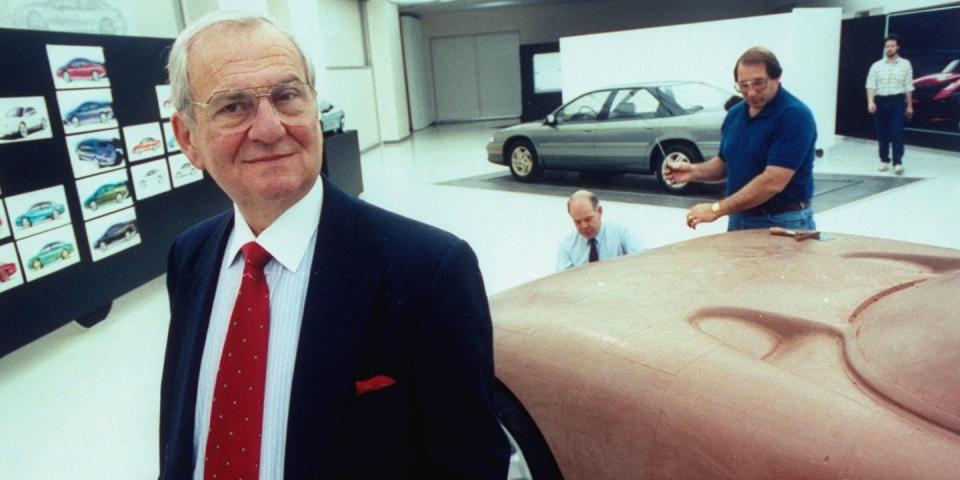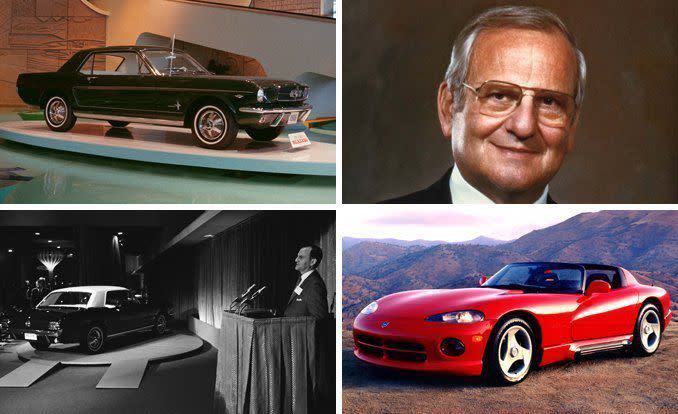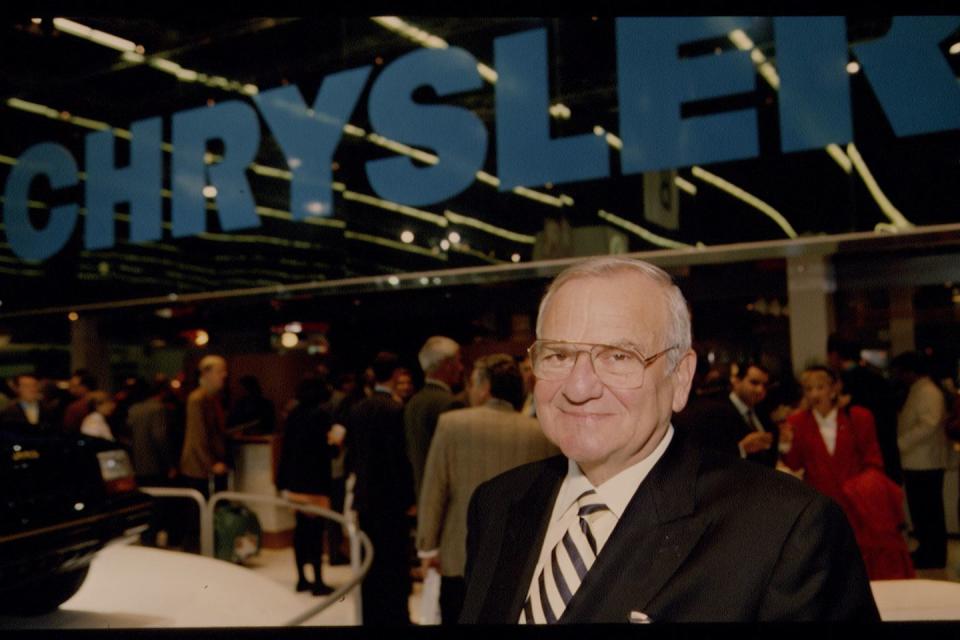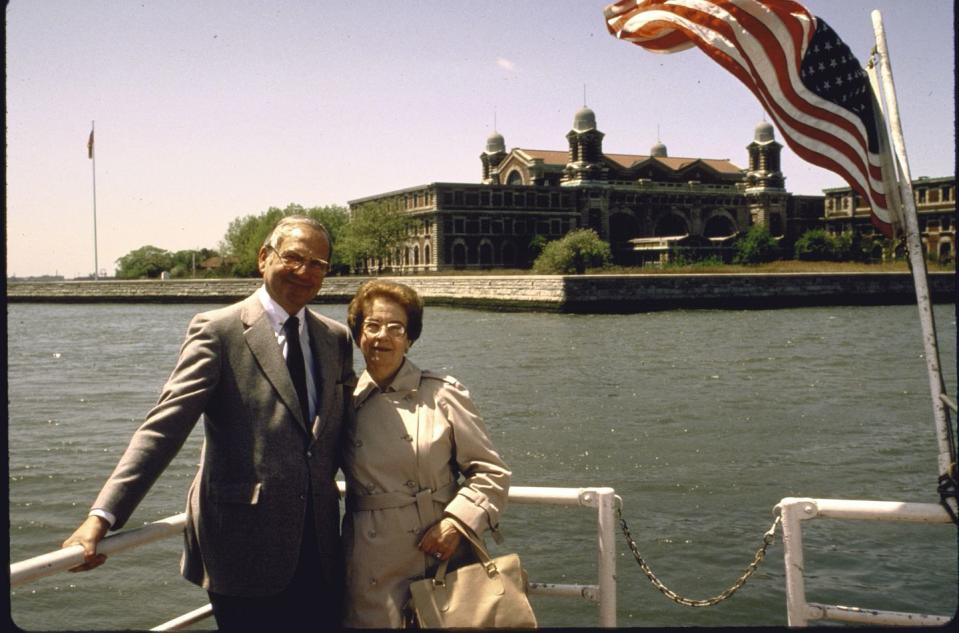Lee Iacocca, Chrysler's Onetime Savior, Has Died at Age 94

Lee Iacocca was a salesman. He sold Fords, he sold Chryslers, he sold Chrysler Corporation, and he sold himself. He was the face of American capitalism who, in the great tradition of American capitalism, put the touch on the American government to keep his enterprise going. He was a celebrity CEO when CEOs weren't supposed to be celebrities. Lee Iacocca passed away today at age 94.
"You can have brilliant ideas," he wrote in his best-selling Iacocca: An Autobiography, "but if you can't get them across, your brains won't get you anywhere." Lido Anthony Iacocca could most certainly get an idea across.
He was born in 1924 in Allentown, Pennsylvania, to Nicola Iacocca and his wife, the former Antoinette Perrotta. Allentown was a thriving steel town then, mostly Pennsylvania Dutch but the sort of place where Italian immigrants could find a community to support them and an opportunity to build a life. Nicola Iacocca found his niche running a hot-dog restaurant called the Orpheum Wiener House.
"My father always drilled two things into me," Lee related in his autobiography: "Never get into a capital-intensive business, because the bankers will end up owning you. (I should have paid more attention to this particular piece of advice!) And when times are tough, be in the food business, because no matter how bad things get, people still have to eat. The Orpheum Wiener House stayed afloat all through the Great Depression."
After graduating from Allentown High School, Iacocca earned a degree in industrial engineering from nearby Lehigh University and afterward was hired by Ford as an engineer. But instead of going to work for Ford right away, Iacocca won a Wallace Memorial Fellowship to study engineering at Princeton University for a year and earn a master's degree. So, it was off to New Jersey first. He finally went to work in Dearborn as a student engineer in August 1946.
"The day I arrived, they had me designing a clutch spring," he wrote. "It had taken me an entire day to make a detailed drawing of it, and I said to myself: 'What on earth am I doing? Is this how I want to be spending the rest of my life?' " He wanted to get into sales.
Starting in the Chester, Pennsylvania, regional sales office, Iacocca was soon a rising star at Ford. By 1949, he was a zone manager out of Wilkes-Barre, visiting dealers and learning the business at the retail level. "Learning the skills of salesmanship takes time and effort," he wrote in his autobiography. "You have to practice them over and over again until they become second nature."
Ford had decided that it would sell the 1956 Fords using safety as a hook despite the fact that, at the time, customers couldn't have cared less about safety, and Ford was facing a sales disaster. That opened the door for Iacocca's first legendary sales push. Working out of Philadelphia, he conjured up the idea that any customer should be able to buy a new '56 Ford for 20 percent down and $56 a month for three years. His "56 for '56" was an instant success, and it got him noticed back at Ford's mother ship.
Also in 1956, he married Mary McLeary, who had been a receptionist at the Ford plant in Chester. They'd have two daughters together before she passed away from complications of diabetes in 1983. He would have two subsequent marriages that didn't stick.
Ford pushed the "56 for '56" campaign nationally, and by 1960 Iacocca had been named vice president and general manager of the Ford Division. Soon after that, his product instincts kicked in with vehicles like the original Mustang-a rebodied Falcon with sex appeal. He had an almost unerring sense of what would sell and how to sell it. By 1967 he was an executive vice president and conjuring up vehicles such as the 1969 Lincoln Continental Mark III.
"One night I was in Canada for a meeting," Iacocca wrote about the Mark III's creation. "I was lying in bed and unable to sleep. Suddenly I had an idea. I put through a call to Gene Bordinat, our chief stylist. 'I want to put a Rolls-Royce grille on the front of a Thunderbird.' " It worked so well that, at the tail end of 1970, Iacocca succeeded the miscast Bunkie Knudsen as president of the Ford Motor Company.
Ford, however, was a family company. And at the top was the chairman of the board, Henry Ford II, the Deuce, with an ego and personality that were maybe larger than even Iacocca's. A clash between them was almost inevitable. After reviving the Mustang with the Pinto-based 1974 Mustang II, pioneering a vast new market with the blatant Mercedes ripoff that was the 1975 Granada, and launching the successful front-drive Fiesta in Europe, Iacocca's star was a burning a bit too bright for the Deuce's taste.

Maybe it was Iacocca's plan to counter the competitive threat of GM's imminent X-cars with a new front-drive car built around a Honda-made engine and transmission. Maybe it was the clash over financing and developing Detroit's Renaissance Center. Or it could have been the disaster that came from recalling more than a million Pintos in June 1978 because of vulnerable fuel tanks that could explode in a collision. But something was the final straw for the Deuce. On July 13, 1978, he fired Lee Iacocca.
The firing was well documented and ugly, and it's now legendary. But Iacocca was still only 54 years old. And his second act would be staggering.
It's hard to overstate what a basket case Chrysler Corporation had become by the late 1970s. "Chrysler Corporation's 1978 annual report reads like a threnody," reported the New York Times in 1979. “The company's share of the total United States auto market was down again, it lost $204.6 million after a $163.2 million profit the year before, earnings per share were down, and the cash dividend was cut. In retrospect, however, that shapes up as the good news-at least in comparison with Chrysler's woeful performance during the first six months of 1979, in which it has lost almost $260 million."
Chrysler was adrift and taking on water, and Lee Iacocca needed a job. He joined the company as president, pretty much on terms he set, in September 1979. On January 1, 1980, he became CEO and chairman of the board.
Chrysler, at that time, couldn't seem to do anything right. It was still reeling from the introduction of the 1976 Dodge Aspen and Plymouth Volare twins, cars that were ordinary but nevertheless plagued by awful quality and a seemingly endless series of recalls. The front-drive Dodge Omni and Plymouth Horizon were running VW powertrains, and Consumer Reports was hammering them with an accusation of dangerous handling. The rest of the products were archaic and easily ignored by buyers. Beyond that, warranty costs were astronomical. Even NASCAR's Richard Petty had stopped driving Chrysler products.
"Chrysler in 1978 was like Italy in the 1860s," Iacocca wrote. "The company was a cluster of little duchies, each one run by a prima donna." But an even bigger problem loomed: The company was running out of cash, and there wasn't an obvious way to get enough to keep the company solvent.
Iacocca could bring the managerial and financial discipline Chrysler needed. He recruited solid managers, among them Gerald Greenwald, to fortify those decisions and build some quality back into the products. But to get the cash needed for the turnaround, Iacocca needed to do the greatest sales job of his life.
Borrowing from banks was nearly impossible. The banks needed a guarantee that their money would be recoverable. After exhausting the alternatives, what was left was asking the United States government for help-in the form of guaranteeing more than $1 billion in loans.
It was while he cajoled, arm-twisted, and seduced Congress to get those loan guarantees that Iacocca went from being a relatively obscure executive to the face of American capitalism. After all, he had to convince the government that Chrysler was worth saving, that it could be saved, and most of all, that he was the right man to lead it back.

Playing to his strengths, Iacocca started his lobbying dazzle with an ethnic appeal. "Almost all 28 members of the informal Italian-American Congressional caucus turned out last Thursday morning for a coffee-and-doughnuts breakfast organized by Representative Frank Annunzio, Democrat of Illinois, and Representative Peter W. Rodino Jr., Democrat of New Jersey," the New York Times reported in December 1979. "The guest of honor was Lee A. Iacocca, chairman of the Chrysler Corporation and Mr. Rodino's old friend. The purpose: to rally support for legislation to provide federal loan guarantees to keep the nation’s third-largest auto company in business."
More challenging was getting the public's support. Suddenly Iacocca was everywhere, showing up on news shows to plead his legislative case and becoming the public face of Chrysler ads to move the metal. Iacocca was great on camera.
Even before Chrysler could shove new product onto the market, there was Iacocca delivering sharply written, clipped sound bites touting confidence, value, and the sheer American-ness of buying a new Chrysler, Dodge, or Plymouth. "If you can find a better car," Iacocca’s signature tag line went, "buy it."
Almost through the sheer strength of Iacocca’s will, along with the promise that the upcoming new K-cars would be world-beaters, enrolling the Congress to save Chrysler was straightforward. After some concessions to labor unions and imposed reforms, Chrysler got its guaranteed money. And by the skin of its corporate teeth, it survived to launch those square-cut front-drivers in late 1980. While the 1981 Dodge Aries and Plymouth Reliant could hardly have been more plain and uninteresting, Iacocca’s crew was soon slicing, dicing, and redecorating them into dozens of variations.
During the 1981 model year, the plain Ks accounted for nearly 36 percent of Chrysler’s total car sales. In '82, tweaked to include the slightly more luxurious Dodge 400 and Chrysler LeBaron, the K derivatives made up 48 percent of sales. There was even a convertible LeBaron offered for the '82 model year. Chrysler was selling so many variations on the K-car that it effectively constituted its entire car lineup in the mid-1980s except for the marginal Omni and Horizon L-cars and the ancient rear-drive M-cars that were sold largely into police fleets. Iacocca knew how to make the K-car pay.
But the greatest K-car derivative of the all was the T115 minivan, sold as the Dodge Caravan and Plymouth Voyager upon its introduction in 1984. It literally revolutionized family transportation in North America, and Chrysler returned to profitability. In fact, Chrysler turned a $10 million profit in October 1980, just after Iacocca completed his first year as company leader.
Iacocca wasn't just an automotive icon by the mid-Eighties but a big presence in the culture at large. Some urged him to run for president of the United States, Johnny Carson cracked jokes about him on the Tonight Show, and he did a guest cameo on Miami Vice as "Parks Commissioner Lido." His 1984 autobiography, co-written with William Novak, was an instant best-seller and so popular that it was the New York Times's best-selling nonfiction hardcover book in both 1984 and 1985 and sold almost 2.6 million copies before being issued in paperback. In a sense, he elevated the role of corporate CEO into that of celebrity.
Iacocca's revival of Chrysler was complete when the company repaid its guaranteed loans in 1985-five years early. From there, Iacocca's Chrysler would acquire AMC and its valuable Jeep brand in 1987 and occasionally pursue quixotic ideas like the misbegotten Chrysler TC by Maserati. For a while, Chrysler even owned Lamborghini.
Lee Iacocca retired from Chrysler in 1992 and would go on to lead other projects like the restoration of the Statue of Liberty. He even teamed up with Kirk Kerkorian in 1995 to take a run at once again controlling Chrysler (it didn't work).

He was a part of automotive culture, but he was more than that: Lee Iacocca transcended his industry to become an American icon. "I was raised to give back," he told C/D’s John Phillips in 2013. "I was born to immigrant parents and was fortunate to become successful at an early age. I've always felt a strong sense of national service to my country, and I may have been able to provide leadership in the political arena. My friend [and former Speaker of the House] Tip O'Neill advised against it, and although I don't regret the decision not to enter politics, I just wonder sometimes if I could have changed anything."
He changed plenty.
('You Might Also Like',)

 Yahoo Autos
Yahoo Autos 